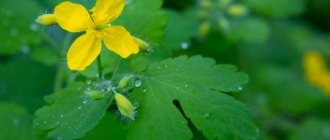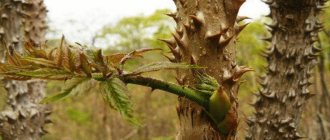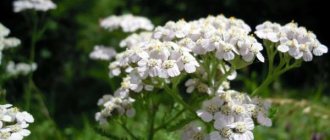Meadowsweet is a representative of the genus of meadowsweet (Filipendula), numbering more than 15 species, of which 8 can be found in the CIS, belongs to the Rosaceae family.
Meadowsweet is widespread everywhere. This is a beautiful plant with a honey-sweet-fragrant strong odor. Many species are grown near houses as ornamental plants and are honey plants. Some representatives, such as six-petalled meadowsweet and meadowsweet, are used in cooking, used as a tea substitute, and as a multivitamin.
Meadowsweet. Other names
Latin name: Filipendula ulmaria (L.) Maxim. (Spiraea ulmaria L.)
Other names: meadowsweet, oregano, whitehead, white grass, oregano.
Other types of meadowsweet
In addition to meadowsweet, this genus includes the following species, which to varying degrees have beneficial and medicinal properties:
- meadowsweet – Spiraea crenata L. (Serenildfia S. A. Meu),
- meadowsweet – Spiraea hipericifolia L.,
- meadowsweet – Spiraea salicifolia L.,
- Siberian meadowsweet – Spiraea sibirica,
- medium meadowsweet – Spiraea Franz Schmidt,
- six-petalled meadowsweet – Filipendula hexapetala Gileb.,
- meadowsweet,
- Kamchatka meadowsweet, shelamaynik – Filipenduia camtshatica (Pall.) Maxim. (Spiraea camtshatica Pall.), etc.
Botanical characteristics
Meadowsweet is a perennial herbaceous plant. Height – 1.5-2 m. The roots are creeping, thin, fibrous. The stem is straight, smooth, ribbed, branched in the upper part, and completely covered with leaves.
The leaves are similar to those of elm (hence the name of the species), intermittently pinnately dissected. They consist of 3-4 pairs of lateral oval pointed incised-serrate leaves, between which there are small double-serrate intercalary lobules. At the top there is one large leaf, divided into 3-5 lobes. The leaves are pubescent, the color is dark green above, whitish below.
The flowers are small, white, yellow-white or cream, collected in a spreading panicle (up to 20 cm long) at the top of the stem. Very fragrant.
The fruit is a multi-nut, breaking up into spirally twisted nuts.
It blooms in May-June, the fruits ripen in July-August.
What does meadowsweet grass look like and where does it grow?
Meadowsweet is a genus of perennials in the Rosaceae family. The herbaceous plant includes several varieties that differ in external characteristics.
Meadowsweet, the photo and description of which are located below, has several name options:
- meadowsweet;
- meadowsweet;
- larkspur;
- Ivanov color;
- sludge.
The height of the meadowsweet bush can reach 2 m.
Meadowsweet has a wide and long root. The straight stem is covered with large feathery leaves. Flowering is observed by mid-summer. Then fruits appear that resemble nuts. The pink or white flowers of the perennial have 6 petals. They are collected in peculiar panicles.
Meadowsweet can be found throughout Europe. Meadowsweet prefers damp meadows, shady forests and floodplains.
Habitat
Meadowsweet (whitehead) is common in the European part of the CIS (Ukraine, Moldova, Belarus, Russia), the Caucasus, Western and Eastern Siberia, Central Asia and Mongolia.
The plant prefers damp, damp wetlands. It can be found in forest and forest-steppe zones in sparse forests, in clearings, along the slopes of ravines, in damp swampy meadows, near reservoirs among other moisture-loving herbs.
In river valleys / in floodplains, along the banks of lakes,
Harvesting and collecting whitehead (meadowsweet)
Meadowsweet is a plant recognized by both folk and official medicine. The leaves and flowers of the plant, and less commonly the roots, are used for medicinal purposes.
The above-ground part is harvested during flowering. Drying meadowsweet flowers should be done quickly to avoid blackening. Shelf life is one year.
The roots of the plant are dug up in early spring or autumn, shaken off the ground, and washed in cold water. The raw materials are dried, as usual, in the shade or in a well-ventilated area, spread out in a thin layer, not forgetting to periodically loosen them to avoid rotting. Shelf life is three years.
Raw materials are stored in paper, canvas bags and boxes. Flowers can be stored in closed glass jars.
Reproduction methods
Meadowsweet can be propagated in several ways: by dividing the bush, by seeds and part of the rhizome.
Growing from seeds
Meadowsweet seeds require natural stratification and hardening. That is why it is recommended to sow them before winter. To begin with, from the area chosen for sowing, you need to remove all the weeds, after which it is moistened. The seeds of this plant are highly photosensitivity. In this regard, it is recommended to sow them in a shaded place (not in the shade). Later, the grown seedlings can be planted in a permanent place.
Seed material should be buried no more than 50 mm into the soil. Otherwise, the sprouts will not be able to break through the thick layer of soil. The distance between seeds should be from 0.3 to 0.4 m. Thanks to such sparse planting, young plants will be able to grow and develop within normal limits without interfering with each other.
The first seedlings should appear in the second half of April or in the first half of May. They are characterized by very slow growth. As a rule, by the end of the season, up to five leaf blades are formed on each bush. In this form they spend the winter under the snow. The bushes will bloom for the first time only in the second or third year of growth. If the plant is in unsuitable conditions for growth, it may bloom much later.
If desired, seeds can be sown in the spring. Before sowing, seed material needs to be prepared. To do this, it is immersed for some time in a solution of a growth stimulator, for example, Novosil or Zircon. Crops need timely and proper moisture, as well as shading, which can be artificial or natural. But even if you do everything correctly, be prepared for the fact that the seeds will not germinate when sowing in spring.
Meadowsweet seeds remain viable, as a rule, for 6 years. However, the germination period can be significantly reduced; this is greatly influenced by the place of collection or cultivation.
If you nevertheless decide to sow meadowsweet in the spring, then keep in mind that the bushes that appear will grow extremely slowly, and their first flowering will not occur earlier than in the third or fourth year of growth. Therefore, despite the fact that you sow meadowsweet in the spring, it will bloom much later than the bushes that grew after winter sowing.
Dividing the bush
Propagation of meadowsweet by dividing the bush is more popular among gardeners than by seeds. You can divide the bush into parts in the autumn, when it has finished blooming, or at the very beginning of spring - from March to April. When choosing the time to divide the bush, you should remember that after a spring transplant, meadowsweet will bloom later than after an autumn transplant.
Dig the bush out of the ground and divide its rhizome into several parts. It is recommended to plant the divisions in the soil immediately after division. If you divided the plant in the fall, but plan to plant the divisions only in the spring, in order to preserve them, it is recommended to bury parts of the bush in moistened sawdust or soil.
When planting cuttings, a distance of at least half a meter should be maintained between them. They should be buried no more than 50 mm into the soil. In the hole, the roots should be positioned horizontally, with the pointed tips of the buds pointing upward. Remember that there should be no weeds or plant debris near young bushes. Also, do not forget about good drainage and constant soil moisture. The cuttings take root quite well, and they bloom much earlier than bushes grown from seeds.
Chemical composition
Meadowsweet has a high content of tannins. In their leaves - 13.3-35.46%, in stems - 3.26-12.97%, in rhizomes - 11.82-39.5%. In addition, a high percentage of ascorbic acid (376 mg%) and carotene were found in the plant’s grass. Therefore, it, like flowers, has long been used to prepare aromatic healing vitamin tea, especially popular in Siberia.
Also, the aerial part of the meadowsweet contains phenolic compounds, phenol glycosides (spirein, etc.), chalcones, caffeic and ellagic acids, catechins, flavonoids (hyperoside and avicularin), steroids, higher fatty acids (stearic, linoleic, etc.), essential oil and aromatic compounds (vanillin, methyl salicylate, salicylic aldehyde, heliotropin, terpene), as well as free salicylic acid.
In addition to tannins, the roots of the plant contain ascorbic acid, traces of coumarins, phenolic compounds, phenol glycosides (spirein, monotropitin), flavonoids and chalcones.
Useful and medicinal properties of meadowsweet
Meadowsweet has numerous beneficial and medicinal properties:
- vasodilator
- painkillers,
- anti-inflammatory,
- hemostatic,
- wound healing,
- antiulcer,
- sweatshop,
- expectorant
- sedative
- diuretic,
- antirheumatic,
- astringent,
- anthelmintic,
- restorative.
Classification
Meadowsweet is a typical representative of the genus Meadowsweet, the rosehip subfamily, and the Rosaceae family. The genus name in Latin is Filipendula, which means “hanging threads”, as its roots are suspended on thin threads.
The name of the species is elm, a derivative of the noun “elm”.
Popularly it is also called meadowsweet, lungwort, whitehead, and honeyberry.
Therapeutic effects of meadowsweet on the body
In order for the treatment to be effective and not bring any unwanted complications, all the medicinal properties and contraindications of meadowsweet should be taken into account, and this can only be done by a doctor who is well acquainted with herbal medicine. Therefore, before starting to take plant preparations, consult a doctor you trust; the information given below is for informational purposes only.
Cardiovascular diseases
The medicinal properties of whitecap have been used for diseases of the cardiovascular system. An infusion of flowers and a decoction of the roots help with high blood pressure, due to which the pressure drops by about 40% in just 20 minutes.
An infusion of meadowsweet flowers is recommended for the treatment of heart diseases, shortness of breath, and helps cope with headaches.
In addition, the infusion of the above-ground part of the plant helps eliminate edema of various origins.
Gastrointestinal diseases
The beneficial and medicinal properties of whitecap also extend to the gastrointestinal tract. An infusion of the herb is used for inflammatory processes and pain in the stomach and intestines, indigestion, diarrhea and dysentery, and other similar conditions. This remedy helps to establish decreased intestinal motility, it is used to treat hemorrhoids and expel worms.
The roots of the plant are also used as an astringent for dysentery.
Respiratory diseases
Herbal medicine has found the use of meadowsweet for the treatment of the throat and various diseases of the bronchopulmonary system. An infusion of the herb is taken orally as a diaphoretic, anti-inflammatory and expectorant for colds, including pneumonia and bronchitis, as well as flu and cough. It is also used for gargling.
In addition, the decoction is drunk for pulmonary tuberculosis (especially with hemoptysis) and bronchial asthma.
Oncology
A decoction of the roots of the plant has proven itself well for the treatment of certain cancer diseases.
For women
The medicinal properties of meadowsweet are used to treat gynecological diseases. An infusion of the herb is drunk for uterine bleeding, and also as a collection for infertility. In addition, both the grass and the roots are used for douching for leucorrhoea and other similar pathologies.
Also, an infusion of the aerial part of the plant shows good results as a rinse to enhance hair growth.
For the liver
The medicinal properties of the whitecap herb are recommended as an anti-inflammatory agent for liver diseases, including hepatitis.
Bladder and kidney diseases
Official and traditional medicine use the medicinal properties of meadowsweet (both roots and herbs) as a diuretic and anti-inflammatory agent for diseases of the kidneys and bladder, such as nephritis, cystitis, etc. In addition, the infusion of the herb is an effective remedy for pain in the kidneys.
Nervous system diseases
Whitehead has benefits for the treatment of diseases of the nervous system. For these purposes, preparations of all parts of the plant are used. They are used for hysteria, convulsions, epilepsy, insomnia, as a sedative (sedative).
For joints and muscles
The medicinal properties of meadowsweet have proven themselves well in eliminating problems with muscles and joints. For this purpose, decoctions and infusions of the plant are used as rubs, compresses, lotions, baths for various joint diseases, polyarthritis, rheumatism, radiculitis, gout, osteomyelitis (has a strong antimicrobial effect). This remedy helps with various neuralgia and neuritis.
In addition, preparations from all parts of the plant are taken orally for rheumatism and gout.
Skin diseases
Preparations of all parts of the plant are used for rubbing, compresses, and baths for some skin diseases, such as furunculosis and psoriasis.
An ointment made from fat obtained from fresh river fish is used in traditional medicine to treat eczema.
Wounds, ulcers, burns...
The numerous properties of whitecap have been widely used for various damage to the skin. Decoctions and infusions from the roots or aerial parts of the plant are used to treat wounds (including long-term non-healing ones), ulcers, burns, diaper rash, etc. They have a hemostatic, wound-healing and anti-inflammatory effect.
For these purposes, lotions, rinses, powders (leaves crushed into powder), and ointment are made. It has been practically proven that a 20% tincture of the herb in 20% alcohol has a pronounced antibacterial effect and promotes faster healing of trophic ulcers.
For bites from poisonous snakes and animals, traditional medicine has long recommended applying lotions to the bite site or applying crushed grass. In addition, you need to drink a decoction of the plant.
Application in cosmetology
The meadowsweet plant, the photo and beneficial properties of which are indicated above, is used not only for medicinal purposes. Meadowsweet promotes:
- eliminating acne;
- narrowing of pores;
- regulation of sebum production;
- moisturizing and nourishing the skin;
- strengthening hair and giving additional volume.
To get rid of acne and pimples, meadowsweet decoctions are mixed with carrot juice and honey. The mask is applied to the face in five layers and washed off after 20 minutes. Cosmetologists note that a product based on meadowsweet allows you to cleanse the skin and restore its velvety feel.
Rinse your hair with meadowsweet decoctions after each wash. The composition has a stimulating effect on dormant follicles.
Dosage forms and recipes
Herbal infusion
1 tsp pour 200 ml of meadowsweet herb. boiling water, cover with a lid, insulate and leave for 2 hours. Strain, squeeze out the raw materials.
Take 1 tbsp. 3 times a day before meals.
Root decoction for internal use
1 tsp Pour 400 ml of meadowsweet roots. water, bring to a boil and simmer in an enamel bowl over low heat for 15 minutes. Remove from heat, cover with a lid, insulate and leave for 45 minutes. Strain through 2-3 layers of gauze, squeeze out the raw materials, bring the resulting broth with boiled water to the original volume.
Take 1-2 tbsp. 3 times a day before meals.
Root decoction for external use
It is prepared in the same way as the decoction for internal use, but at the rate of 20 g. raw materials per 1 liter. water.
Indications for use. Leucorrhoea (douching), diarrhea (enemas), fistulas and purulent wounds (washing).
Infusion of flowers
1 tsp pour 200 ml of meadowsweet flowers. boiling water, cover, wrap and leave for 1 hour. Strain, squeeze out the raw materials.
Take half a glass 3 times a day before meals.
Leaf tincture
To prepare the tincture, both leaves and leaves together with inflorescences are used. It is better to use dark glassware or put a black nylon stocking or golf stocking over a glass jar.
100 crushed raw materials pour half a liter of high-quality vodka (20%). Close the container tightly and leave in a dark place at room temperature for a week, remembering to shake periodically. Strain, squeeze out the raw materials.
Take 1 tsp. 3 times a day.
Indications for use. Diseases of the stomach, kidneys, bladder, as a diuretic, colds, gout, rheumatism. Externally for the treatment of wounds, ulcers, and skin diseases.
Herbal ointment
Grind the whitecap herb into powder. 5 gr. Grind the powder well with 9 g. Vaseline and 6 gr. lanolin (sold in pharmacies).
Indications for use. Burns and skin diseases.
Contraindications
Meadowsweet helps in treating a huge number of diseases, but not everyone can use it. Therefore, before using the plant, you should consult a doctor.
Who can meadowsweet harm? It was stated above that pregnancy and lactation are contraindications, as well as individual intolerance to the extract. If you have regularly high blood pressure, you should not use the plant too often.
For chronic constipation, it is not recommended to use meadowsweet, as it may aggravate the existing problem. If there are disturbances in blood clotting, as well as thrombocytopathy, the use of meadowsweet is prohibited.
Meadowsweet turned out to be such a healing herb. If you have the opportunity, plant it in your dacha and you will be healthy!









